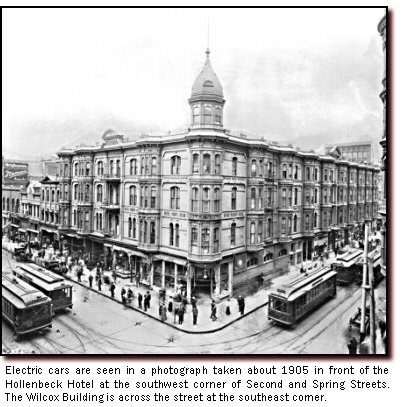Metropolitan News-Enterprise
Thursday, February 8,
2007
Page 15
REMINISCING
(Column)
100 Years Ago, Electric Tracks Spanned County and Beyond
By ROGER M. GRACE
A hundred years ago, the
map of Los Angeles County was criss-crossed by interconnected lines
representing the tracks of street cars, vehicles propelled by electricity fed
from overhead wires.
The Wilcox Building at Second and
Spring in downtown Los Angeles, the structure which housed the upscale grocery
store of Hans Jevne, could be reached by southbound rail cars coming from
Burbank, Glendale, Casa Verdugo (an area later annexed by Glendale), Pasadena,
Altadena and mountain areas to the north. It could be accessed from eastern and
south-eastern points including Alhambra, Dolgeville (now part of Alhambra),
Norwalk, and Clearwater (presently known as Paramount). Rail cars came north
from Wilmington and San Pedro, and from Alamitos Heights and the city which
later absorbed it, Long Beach. There were downtown-bound lines starting in the
west at Redondo Beach, Playa del Rey, Santa Monica, and Ocean Park (then a
city, later renamed “Venice,” now an area of the City of Los Angeles).
The editor/owner of this publication in
1907, Susie P. Miller, could have travelled (and very well might have) by
electric rail from her office in Sawtelle—then a city, just west of what would
later become Westwood—to Jevne’s…little suspecting that the Jevne premises
would, a century later, be the home of her newspaper.
A century ago, it was a quick trip
to L.A. from Hollywood…which, at that time, also was a city. (Its founder,
Harvey Wilcox, was not connected to the Wilcox Building in downtown L.A.)
Sawtelle and Hollywood were in 1907
part of the Pacific Railway’s “Balloon Route Trolley Trip,” traveled both by
locals and by tourists. The route included the beach cities, as well as Laurel
Canyon (then spelled “Canon,” based on the Spanish, “Cańon”), Colegrove (South
Hollywood), Sherman (West Hollywood) and Westgate (Brentwood). (A 1905
California Supreme Court decision tells of a special “lemon train” dispatched
every now and then to Colgrove from Sherman to pick up lemons, destined for
Santa Monica.)
There was electric traffic between Los
Angeles and various points in Orange County. A passenger could get on an
electric car in Huntington Beach (named after the railway’s owner) and go to
Santa Ana, from there to Watts, and on to downtown L.A.
By this time, Second and Spring, though
not lacking in electric car traffic, was no longer where the lines converged.
On Jan. 15, 1905, the  Huntington Building, on the southeast corner of Sixth and
Main, opened. It served both as an office building and the downtown terminal of
the Pacific Electric Railway Company, formed in 1901 by real estate magnate
Henry Huntington, nephew and heir of Southern Pacific Railroad president Colis
Huntington.
Huntington Building, on the southeast corner of Sixth and
Main, opened. It served both as an office building and the downtown terminal of
the Pacific Electric Railway Company, formed in 1901 by real estate magnate
Henry Huntington, nephew and heir of Southern Pacific Railroad president Colis
Huntington.
Henry Huntington in 1898 had bought up
the stock of the Los Angeles Railway Company, and proceeded to acquire other
transit companies, tearing out what cable lines still remained, constructing
electric lines in their place.
Today, southbound buses go past our
building on Spring Street. Public transportation began on that street 132 years
ago. It was in 1874 that a horse-drawn street car system was installed on
Spring, with passengers going to and from the business area surrounding the
plaza into the residential area south of First Street.
By 1907, electric railways had
supplanted cable lines...which succeeded horse-drawn cars on tracks...which
came after horse-drawn conveyances that weren’t on tracks. A July 1, 1903,
California Supreme Court opinion had an upbeat prognostication as to the future
of electric transit, saying:
“Electric roads…were first operated
upon the streets of a municipality. They next extended out upon the suburban
roads and county highways. They now run freely between counties. They are
projected over all parts of the state, and, if the expressed conviction of many
prominent engineers is to be credited, it will not be long before even between
states they will to a great extent have supplanted the present steam
railroads.”
Copyright 2007, Metropolitan News Company
MetNews Main Page Reminiscing
Columns
 Huntington Building, on the southeast corner of Sixth and
Main, opened. It served both as an office building and the downtown terminal of
the Pacific Electric Railway Company, formed in 1901 by real estate magnate
Henry Huntington, nephew and heir of Southern Pacific Railroad president Colis
Huntington.
Huntington Building, on the southeast corner of Sixth and
Main, opened. It served both as an office building and the downtown terminal of
the Pacific Electric Railway Company, formed in 1901 by real estate magnate
Henry Huntington, nephew and heir of Southern Pacific Railroad president Colis
Huntington.